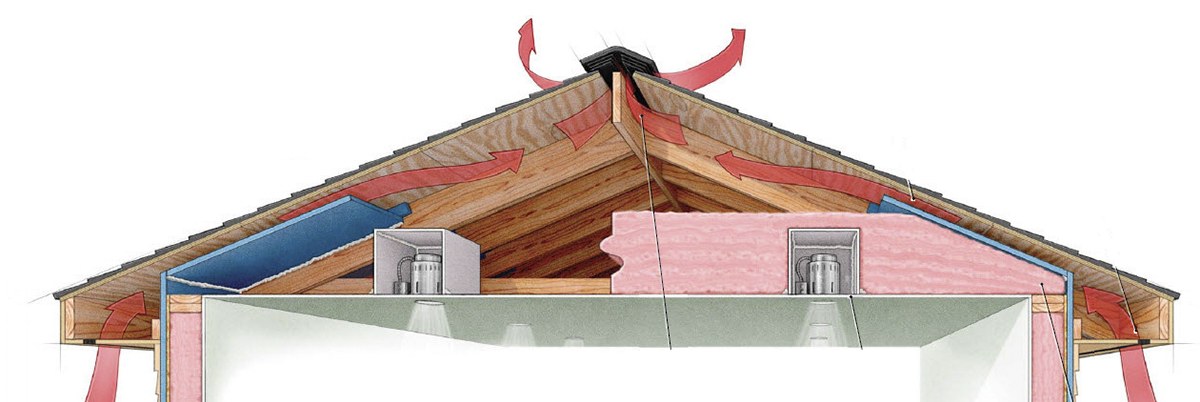 Understand the Importance of Attic Ventilation and Roof Health
Understand the Importance of Attic Ventilation and Roof Health
Posted on Wednesday, February 20, 2019
Categories:
Roofing & Siding
|
Ventilation
We all want our homes to be warm in the winter and cool in the summer. For some, the idea of allowing cold winter or hot summer air into your attic just seems wrong. However, your attic provides a middle ground or buffer between the extremes of the outside temperatures and the relatively constant temperature inside your home, without adding to the floor space that you need to heat and cool.
Without air movement, moist air from inside your home escaping into the attic (around light fixtures, fan ducts, or attic entrances) gets trapped there. Over time this trapped moisture gets into the insulation (reducing its effectiveness) as well as wooden joists and rafters. Mold and mildew start to grow and the wood rots. Air movement gets that moisture out of the attic.
Effective attic ventilation systems reduce damaging heat and moisture in your attic, promote energy efficiency by helping to reduce the load on your air conditioner in the summer, reduce the risk of ice dam formation on your roof in the winter, and prolong the life of your shingles.
How much is too much? As long as you have a “balanced” system, you cannot over ventilate your attic. Just remember if you increase the amount of exhaust ventilation – you must have an equal amount of intake. The ventilation system needs to be 50% intake and 50% exhaust.
Exhaust ventilation allows hot, moist air to escape at or near the roof ridge. Install all exhaust vents at the same height within a common attic area. Installation of vents at more than one level on a roof allows the upper exhaust vent to pull air in from lower exhaust vents rather than pull from the intake vents installed at the lower portion of the roof.
Intake is very important to the ventilation system. Unfortunately, intake is often overlooked. In fact, inadequate intake is the number one reason for failure of an attic ventilation system. Lack of intake vents results in extreme heat buildup in the summer and severe moisture problems in the winter. Additionally, exhaust vents can actually become intake vents if no intake vents are present and pull in rain and snow. You must have a continuous supply of fresh air to “feed” the exhaust vents. The intake system must provide as much or more than the exhaust system in net free area.
Roof Health: Adequate attic ventilation is critical to roof health. An overly hot attic can fry the bottom of your asphalt shingles, accelerating wear and causing them to curl. Without sufficient ventilation, your home can’t breathe out excessive moisture, paving the way for condensation and mold growth. If this issue is left unaddressed, your new roof will be in bad shape in no time.
Ice Damming: A key point to remember when considering ice dams - the temperature should be the same inside the attic as it is on the exterior of the home if the attic is insulated.

Ice damming occurs in the following situations:
- There is not enough insulation and poor air infiltration between the attic and the living space. This causes warm air to rise and go into the attic.
- The warm air in the attic melts the snow on the roof deck.
- The melted snow begins to run off the roof.
- Once it hits the soffit area it begins to freeze. It freezes over the soffit because the warm air that was under the roof is no longer there and the cold air under the soffit begins to freeze the melted snow.
- As the snow accumulates on the roof time-and-time again after each snow fall, the ice dam gets bigger.
A common misconception heard from homeowners every year is, "I have ice and water shield on my roof - so I shouldn't get ice dams."
How are Ice Dams prevented?
Stopping ice dams is simple, in principle: keep the entire roof the same temperature as the eaves. You do that by increasing ventilation, adding insulation, and sealing off every possible air leak that might warm the underside of the roof. Using the Deck-Air, Model DA-4, is a solution for homes with inadequate intake ventilation.
Ice and water shield isn't made to prevent ice dams, it is used to help stop ice and water from infiltration into the roof once ice dams form. It does not prevent ice dams, but rather protects you from ice dams once they form.
[Sources: GAF, Lomanco, DoItYourself, AirVent Inc]
Tagged:shingles, roofing, home improvement, condensation, humidity, ventilation